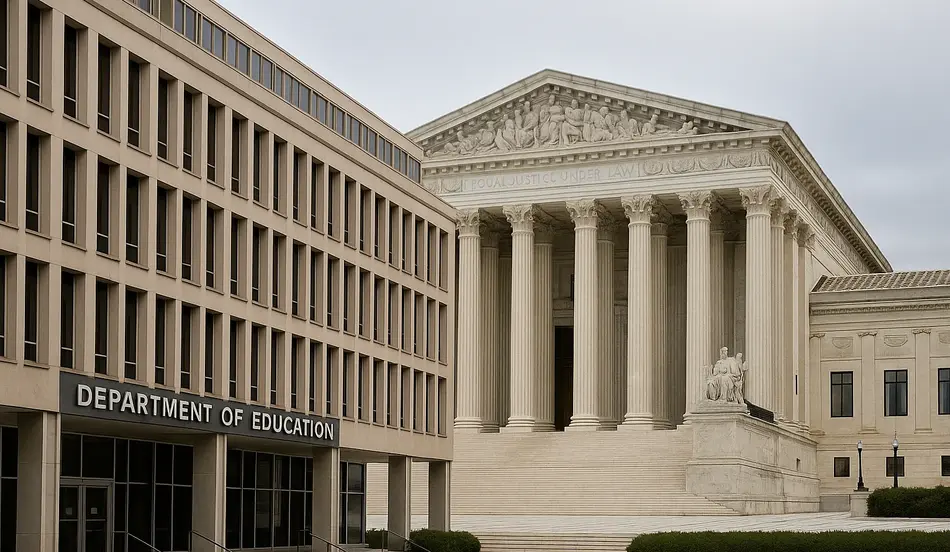In a significant ruling that could reshape federal education policy for years to come, the US Supreme Court has cleared the way for President Donald Trump’s administration to resume dismantling the Department of Education. This landmark decision represents a major victory for the Trump administration’s efforts to reduce the federal government’s role in education and shift more control to individual states. For more details, see SCOTUSblog.
The Supreme Court’s Decision on Department of Education Dismantling
The Supreme Court’s action came in a brief, unsigned order that lifted a federal judge’s previous ruling which had reinstated nearly 1,400 workers affected by mass layoffs at the department. The high court’s decision also removed blocks that had prevented the administration from transferring key functions to other federal agencies.
The court’s three liberal justices—Sonia Sotomayor, Elena Kagan, and Ketanji Brown Jackson—dissented from the majority opinion. In a strongly worded dissent, Justice Sotomayor called the court’s decision “indefensible,” writing that it “hands the Executive the power to repeal statutes by firing all those necessary to carry them out.”
“The majority,” Sotomayor continued, “is either willfully blind to the implications of its ruling or naïve, but either way the threat to our Constitution’s separation of powers is grave.”
Trump’s Vision for Education: Returning Power to the States
Created by Congress in 1979, the Department of Education has primarily been responsible for administering college loans, tracking student achievement, and enforcing civil rights in schools. It also provides federal funding for disadvantaged districts and students with disabilities. Learn more at the Department of Education official site.
President Trump has long positioned the department as a symbol of bureaucratic waste and federal overreach. In March, he signed an executive order calling for the department’s closure “to the maximum extent allowed by law,” declaring, “We’re going to be returning education very simply back to the states where it belongs.”
Under this plan, the Trump administration directed that the department transfer its $1.6 trillion student loan portfolio to the Small Business Administration and its special education services to the Department of Health and Human Services.
The Legal Battle Over Department of Education Dismantling
The legal challenge to these actions was brought by a coalition of 21 Democratic attorneys general, school districts, and teachers’ unions. They argued in court papers that Trump’s shutdown efforts threatened to impair the department’s ability to perform its core duties.
Boston-based US District Judge Myong Joun had previously concluded that the mass firings would “likely cripple the department” and ordered the affected workers to be reinstated. The Supreme Court’s decision effectively overturns this ruling.
Education Secretary Linda McMahon called the court’s action a “significant win for students and families,” stating that the “US Department of Education will now deliver on its mandate to restore excellence in American education.”
Impact on Education Across America
The decision raises significant questions about how federal education functions will be maintained moving forward. Critics warn that the mass firings could delay the disbursement of federal aid for low-income schools and students with special needs, potentially requiring cuts to programs or teaching staff.
They also argue that Trump’s shutdown effort could undermine efforts to curb discrimination in schools, analyze and disseminate critical data on student performance, and assist college applicants seeking financial aid.
The Future of Federal Education Policy
While the Supreme Court’s decision allows the Trump administration to proceed with its plans to reduce the Department of Education’s workforce, completely eliminating the department would still require an act of Congress.
The downsizing announced in March by Education Secretary Linda McMahon aimed to slash the department’s staff to roughly half the size it was when Trump took office in January. This reduction in force reflects what McMahon described as “the Department of Education’s commitment to efficiency, accountability, and ensuring that resources are directed where they matter most: to students, parents, and teachers.”
As this legal battle continues in the lower courts, the future of federal education policy remains uncertain. What is clear, however, is that the Supreme Court’s decision marks a significant shift in the balance of power between federal and state control over education in America.
What This Means for Students and Schools
For students, parents, and educators across the country, the implications of this decision could be far-reaching. While the Trump administration has promised to preserve certain “core necessities,” including Pell grants to students from lower-income families and federal funding for disadvantaged students and children with special needs, questions remain about how effectively these programs will be administered under different agencies.
Critics worry that without a dedicated Department of Education, important protections for vulnerable student populations could be weakened or lost entirely. Supporters counter that reducing federal bureaucracy could lead to more efficient and responsive education systems at the state and local levels.
As the education landscape continues to evolve, staying informed about changes in policy and funding is crucial for students, parents, and educators alike. Understanding how these shifts might impact educational opportunities and resources can help communities better prepare for the future.
Hiring?
Post education jobs for free with WhatJobs – Connect with qualified candidates today!
Post Jobs NowFAQ: Supreme Court Department of Education Dismantling
What exactly did the Supreme Court decide regarding the Department of Education?
The Supreme Court lifted a federal judge’s order that had blocked the Trump administration from laying off nearly 1,400 Department of Education employees and transferring key functions to other federal agencies. This decision allows the administration to proceed with its plans to significantly reduce the department’s size and scope.
Will the Department of Education be completely eliminated?
While the Trump administration has expressed a desire to close the department, complete elimination would require an act of Congress. The current actions focus on reducing staff and transferring certain functions to other agencies, effectively diminishing the department’s role without formally abolishing it.
How might the dismantling of the Department of Education affect student loans?
Under the Trump administration’s plan, the department’s $1.6 trillion student loan portfolio would be transferred to the Small Business Administration. This transition raises questions about how loan processing, forgiveness programs, and borrower protections might change under different management.
What happens to federal funding for special education and disadvantaged students?
The administration has stated that certain “core necessities,” including federal funding for disadvantaged students and children with special needs, would be preserved but redistributed to other agencies and departments, such as the Department of Health and Human Services for special education services.
How will this decision impact state and local control of education?
The move aligns with the administration’s stated goal of returning education authority to state and local governments. While federal law already prohibits the department from controlling school operations, including curriculum, instruction, and staffing, this further reduction in federal oversight could potentially increase state autonomy in education policy.
By creating this comprehensive analysis of the Supreme Court’s decision on the Department of Education dismantling, we’ve provided readers with valuable insights into this significant policy shift and its potential implications for American education.




